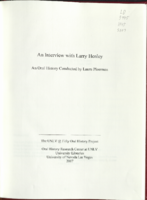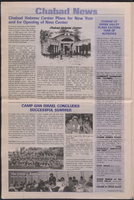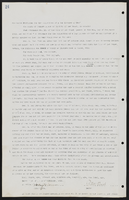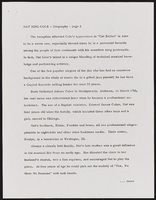Search the Special Collections and Archives Portal
Search Results

Transcript of interview with Hank Gordon by Claytee D. White and Stefani Evans, October 26, 2016
Date
Archival Collection
Description
As we go about our days, running errands and getting things for our households, we often don’t think too much of the story behind the commercial real estate and retail stores we frequent. Only when those stores aren’t there and the neighborhood demographic changes do we embrace the nostalgia that goes into the story of the neighborhoods where we live and shop. Hank Gordon is the man behind those memories of those shopping centers we frequent not only in the Las Vegas Valley, but in Washington, Oregon, Montana, California and Alaska as well. Gordon was raised in Los Angeles and graduated from USC in 1956, when he went to work for a home builder in the San Fernando Valley selling his houses to make some extra weekend money. It was during this time he fell in love with real estate and had to break the news to his parents that he no longer was going to be a doctor. Feeling the urge of leadership he told his mentor that he didn’t want to sell houses-he wanted to develop homes instead. Shortly after that he bought a subdivision of lots in Van Nuys and started building 7-11 and Goodyear stores in the early 1960s. In this interview, Gordon talks about building his first shopping center in 1967 and moving to the Pacific Northwest. He moved to Las Vegas in 1988, when he bought 23 new national retailers to the Valley. He was responsible for bring Home Depot in 1999 and Costco and Best Buy to some of Las Vegas’s longest-standing shopping centers; Best of the Boulevard on Maryland Parkway and Best of the West on Rainbow Boulevard. He speaks of the changes to the market after the Great Recession, how retailers are having a hard time keeping afloat because of online shopping, and his days on the planning commission for the City of Las Vegas during the 1990s, when Jan Jones was mayor. It is without a doubt that Hank Gordon is one of the best in the business and there isn’t a lot of competition at the top.
Text

Transcript of interview with Earl A. Evans by Lance Malone, March 15, 1981
Date
Archival Collection
Description
On March 15, 1981 Lance Malone interviewed Sears Roebuck Division Manager, Earl A. Evans, Jr., (born March 3rd, 1935 in Alhambra, California) in Las Vegas, Nevada. This interview covers the history of Nevada and Mr. Evans’s life. During the interview, Mr. Evans discusses education, sports, employment, the weather and the railroad in Las Vegas. He also discusses transportation, recreation, community involvement, raising a family in Las Vegas, the development of Fremont and the Strip, and religious activities. Mr. Evans served as a Bishop for the LDS Church in Las Vegas and in regards to education, he served on the Clark County School Board.
Text

Ruby C. Leavitt interview, November 30, 1986: transcript
Date
Archival Collection
Description
On November 30, 1986, collector Patton Alberti interviewed Ruby Canonic Leavitt (born 1907 in Genoa, Nevada) at her home in Reno, Nevada. Mrs. Leavitt discusses her time as a teacher in Verdi, Nevada, as well as other places in Northern Nevada. She also discusses the changes she has seen in teaching and in the towns she has lived in over time.
Text

Transcript of interview with Larry Henley by Laura Plowman, May 23, 2007
Date
Archival Collection
Description
Text
Marsha Giller oral history interview, 2013 October 24
Level of Description
Scope and Contents
In 1960, Giller and her husband purchased the ambulance service in Reno, Nevada. Her company, AIDS Ambulance, was the main provider of ambulance services in Truckee Meadows until 1978. Due to competition between companies, Giller went to work for Mercy Ambulance. She spent over 50 years in the EMS field.
Archival Collection
Collection Name: History of Emergency Medical Services in Nevada Oral History Interviews
Box/Folder: Digital File 00
Archival Component
Ed Tomany oral history interview, approximately 2012 to 2013
Level of Description
Scope and Contents
Tomany received first aid training from the US Forest Service and the US Army in the 1960s. In 1968 he started running on Tonopah, Nevada's ambulance service. Though he had to stop running in the 1970s, he restarted his ambulance career in 1985 and received his EMT certification that year.
Archival Collection
Collection Name: History of Emergency Medical Services in Nevada Oral History Interviews
Box/Folder: Digital File 00
Archival Component

Transcript of an Interview with James Jones, Jr. by Barbara Tabach, February 28, 2013
Date
Archival Collection
Description
James worked for over 30 years at the Test Site before becoming a funeral director at Thomas & Jones Funeral Home. Raised family on Westside.
Text

Chabad Times newspaper of Chabad of Southern Nevada, 2003-2004
Date
Archival Collection
Description
Issues of Chabad Times, a publication of Chabad of Southern Nevada for the years 2003 and 2004. The newspaper includes local interest stories, advertisements, and advice columns.
Text


